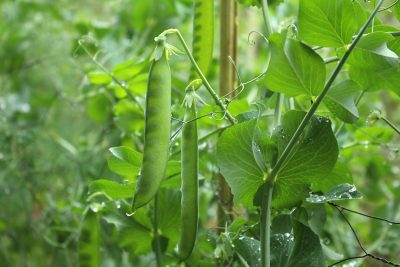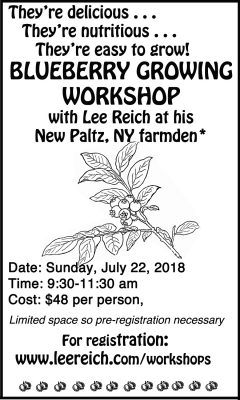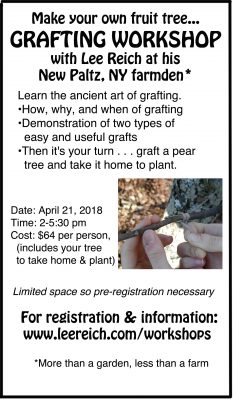Come Visit My Farmden
/7 Comments/in Gardening/by Lee ReichThis Sunday, June 24th, 2018, from 1-4:30 pm my garden/farmden is open to the public as part of the Garden Conservancy’s Open Days program. The Garden Conservancy is an American nonprofit organization founded in 1989 and dedicated to preserving exceptional gardens and landscapes. The $7 admission cost to each Open Day garden helps fund their efforts. For more information about my farmden and other local gardens open that day (and through summer), go to https://www.gardenconservancy.org/open-days/garden-directory/springtown-farmden
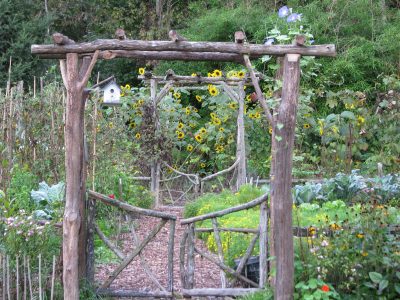
Playing Around With Stems
/7 Comments/in Design, Fruit, Gardening/by Lee ReichTop Doggery
Within any plant a push and pull goes on between fruiting an stem growth. Both require energy, which the plant has to apportion between the two. The more vigorously growing a stem, the less fruitful it is.
All this talk of hormones and inherent stem vigor is more than academic; it can translate into delicious fruits.
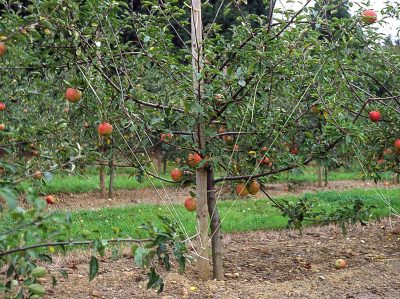
Tied branches in British orchard
But pear trees, especially in the youth, tend to put too much of their energies, too much for me, at least, into stem growth. The result is that they can take long time to settle down and begin bearing fruit.
Hence, the strings. I can change my pear trees’ habits by merely tying down branches, reducing the effect of that auxin so that growth is more uniform along a length of the stem. And, as important, slowing growth nudges the energy balance in the direction of fruiting.
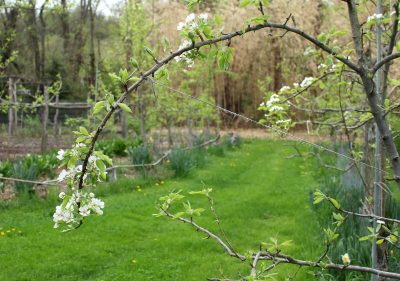
More Fruit or More Growth?
Branch bending is not only for coaxing a tree into fruiting. On young branches, it creates a wide angle between a branch and the developing trunk. Wide angles here have been shown to result in good anchorage, sturdy side branches that can carry a weight of fruit.
Suppressing the vigor of side branches also ensures that they won’t compete with the developing trunk, which needs to be top dog.
And using string to play around with plant hormones isn’t needed on every fruit tree. At the other extreme from pear in its growth and fruiting habits is peach. Peach is naturally very fecund, and becomes naturally so at a very young age.
Beauty, Fruit, and Fun
All this concern with auxin, vigor, and fruiting comes most prominently into play with espalier, which is the training of a tree to an orderly, often two dimensional form. The tracery of the branches themselves adds to the decorative value of the plant.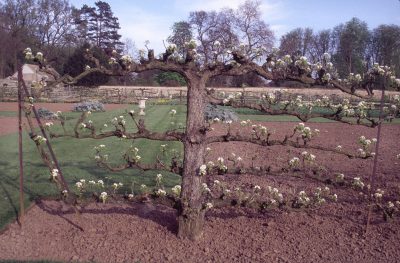
Fruiting espaliers, besides being decorative, produce very high quality fruit. Pruning and branch bending maintain a careful balance between yield and stem growth, and the form of the plant allows leaves and fruits to bathe in sunlight and air.
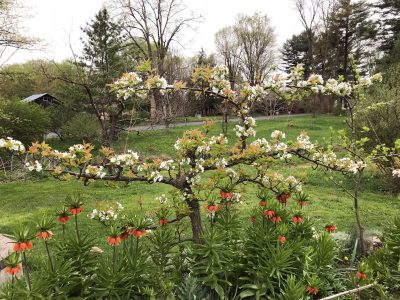
An Onion Relative and a Cabbage Relative
/7 Comments/in Gardening, Vegetables/by Lee Reich
Wild Leeks, Cultivated
I got pretty excited seeing rows of scrappy, green leaves emerging from the ground between a couple of my pawpaw trees. The leaves were those of ramps (Allium tricoccum, also commonly known as wild leeks) that I had first planted there two years ago, with an additional planting last year.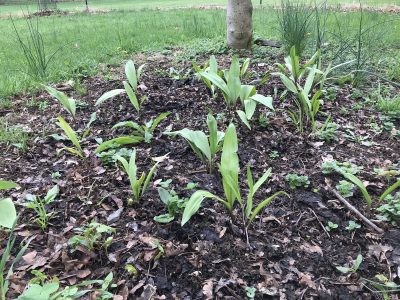
There’s no reason that ramps shouldn’t thrive here on the farmden; they’re native from Canada down to North Carolina and from the east coast as far west as Missouri. They’ve been best known in the southern Appalachian region, where festivals have long been held to celebrate the harvest.
Ramps became more widely known in the 1990s when, with the publication of a ramp recipe in Martha Stewart Living Magazine, the wilding became a foodie-food. Ramps are now threatened with being over harvested. Which, along with a desire to have this fresh-picked delicacy near the kitchen door, is the reason I planted them.
Large patches of ground in a forest preserve in New Jersey near to where a friend lives are blanketed each April with ramp greenery. We had dug up a few — very few — of the ramps, leaves and bulbs, which I transplanted here. Our harvest was not a threat to the ramp population. No one else has ever been seen harvesting there, and we dug up less than 1% of what was there. Research has shown that harvests are sustainable if no more than a different 5-10% of a planting are harvested yearly.
In the wild, ramps thrive in damp soil rich in organic matter in the shade of deciduous trees. My pawpaws provide the deciduous shade. The ground beneath those trees has been enriched each year for 20 years with a thick mulch of autumn leaves. To give the ground a further boost as far as organic matter and nutrients, I lay down a couple of inch thick blanket of compost over the bed last summer.
Over time, the bulbs should multiply and the plants further spread by self-seeding. I plan to harvest some seeds when they ripen in late summer to grow the seedlings under more controlled conditions.
The seeds have a double dormancy so they often don’t sprout until the second spring after ripening. The root dormancy, the result of immature embryos, is overcome with warmth and moisture. A warm autumn might be sufficient; if not, the next growing season. I plan to hurry the process along by potting up the seeds and keeping them warm (about 70°F) and moist for a couple of months. Then I’ll whisk the pot into the refrigerator to overcome the shoot dormancy, which requires a couple of months of cool, moist conditions, to jolt them awake. (More about natural blocks to seed germination in my new book The Ever Curious Gardener: Using a Little Natural Science for a Lot Better Garden.) The seedlings, as might be expected given their natural habitat, grow best with some shade — 30% shade to be exact, according to research.
Ramps are among the few perennial vegetables I grow. They are spring ephemerals, so in just a few weeks, their leaves will dissolve into the ground as the plants go dormant, to return again each spring for my dining pleasure.
A Different “Kale”
Seakale (Crambe maritima) is yet another perennial vegetable that I grow. It’s a cabbage relative that just now is sending up sprouts from its thickened roots. As soon as I noticed the sprouts, I covered the plants with an overturned, clay flowerpot, covering the drainage hole with a saucer to prevent light from reaching the plant.
Seakale tastes best blanched, that is, with its shoots grown in darkness. Under such conditions, leaves stretch out and grow pale and tender. In light, the taste of the leaves is too sharp. Or so I’ve read: Although I’ve grown seakale for many years, I wanted the roots to build up enough energy reserves to fuel new growth in the dark. This year, I will taste seakale.
Seakale will continue to earn a place in my garden even if its flavor falls flat (or sharp) because it’s a beautiful plant. Once released from the dark, new leaves emerge silvery green, large, and wavy. And then, later on in summer, foaming sprays of small white flowers emerge from within the whorl of leaves.
Expect a report on my take of seakale flavor in a couple of weeks, which is the time required for blanching. Like other perennial vegetables, once the harvest period ends, plants need to grow unfettered for the rest of summer to replenish the stored energy they spent fueling spring growth.
Spring?
/11 Comments/in Gardening/by Lee ReichSpring, You’re Late
Seems like everyone — in the northern half of the country east of the Rockies, at least — is talking about this spring’s weather. Robert Frost (in “Two Tramps in Mud Time”) had it right when he wrote:
The sun was warm but the wind was chill.
You know how it is with an April day
When the sun is out and the wind is still,
You’re one month on in the middle of May.
But if you so much as dare to speak,
A cloud comes over the sunlit arch,
A wind comes off a frozen peak,
And you’re two months back in the middle of March.”
Perhaps T. S. Elliot (in “The Waste Land”) was right in writing that “April is the cruelest month.”
But has this past April really been crueler than most? Usually I pooh-pooh day to day impressions. But even Sammy, who usually bounds over to me from his doghouse each morning when he sees me, stayed in and watched as I crossed the yard a couple of weeks ago over ground recently covered with a dusting of snow. 
Phenology, the study of climate as reflected in the natural cycles of plants and animals, is one way to give the weather an objective assessment. For decades, I’ve recorded the dates on which various plants have blossomed. My interest was horticultural: In spring, plants blossom after experiencing a certain accumulation of warm temperatures. So various blossoms can be indicators of when it’s safe to sow seeds or set out plants of various vegetables and flowers.
Depending on late winter and spring weather, blossoming dates for various plants can vary quite a bit. Microclimate also plays a role, so I’ve tried to always note blossoming on the same plant from year to year. Back in 2010, forsythia bloomed about April 1st, the earliest I’ve ever recorded. Contrast that with 2009, when it bloomed about April 15th, or back in 1984, when it bloomed on April 25th!
This year, forsythia bloomed on April 23rd, late again. Over the years, forsythia bloom dates average around the middle of April, so this year is definitely late. All these forsythia bloom dates are for forsythia on my farmden, which is in a local cold pocket so blossoms spread their yellow petals a few days later than plants even just a few miles away.
Another key indicator for me is cornelian cherry (Cornus mas), whose yellow blossoms are most welcome because they frequently open the first day of spring. Not this year though; mine bloomed on April 20th.
Daffodils typically bloom here in early April, although back in 2016, they bloomed on March 25th. This year, April 21st.
One of my favorite blooming shrubs, also producing very tasty fruit, is Nanking cherry (Prunus tomentosa).
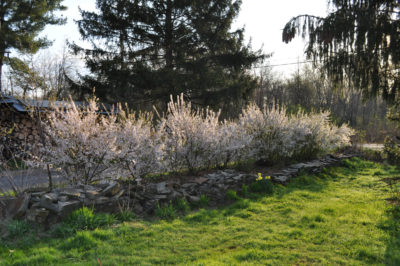
Nanking cherry hedge
Stems on the row of them along my driveway typically form a veritable wave of pinkish white blossoms around the middle of April. As I write, it’s April 24th and that wave is just building. If warm weather continues, it should roll in within a few days. (Update: It did, on the 28th.)
Plants Tell Me When To Plant
It’s tradition to plant corn when “oak leaves are the size of mouse ears.” Considering phenology, I take timing one step further, planting, for example, lettuce seeds
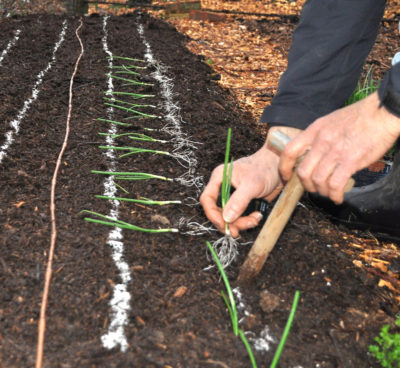
Setting out onion transplants
when forsythias blossom, cabbage transplants when apples blossom, and — this is a tough one — peas a week BEFORE forsythias blossom.
So yes, it has been a “cruel” spring, if you’re wanting some warmth and sun. Then again, this cool weather has retarded, so far at least, blossom development of my fruit trees, which is a good thing. The later these trees blossom, the less chance for the open flowers to be burned by subsequent frosts.
Peas, Where Are You?
The downside to this atypically cool spring weather is that it has delayed planting of annual vegetables and flowers, or their growth if they’s already been planted. I sowed peas, as I always do, on April 1st. Still no sign of the poking up through the ground. I’m going to go outside, scratch around in one of the pea rows, and check if the seeds have either sprouted or rotted.
I’m back. The peas are okay, their first bits of green are peeking up through the surface of the ground.
No matter if the season is unseasonably cool or warm, by this time of year the progression of blossoms provides a feast for the eyes and the nose.
(Micro)climate Change
/3 Comments/in Fruit, Gardening, Planning/by Lee ReichAs the train rolled southbound along the east bank of the Hudson River, I took in the varied landscapes along the opposite west bank. Spilling down the slope to the river on that bank at one point was what appeared, from a distance, to be a vineyard. I was envious.
(I never could understand why the region here is called the Hudson Valley. Along much of the Hudson, the land rises steeply right up from river’s edge. Where’s the valley?)
I wasn’t envious of the riverfront site of the vineyard property. I wasn’t even envious of having a whole vineyard of grapes. (I cultivate about a dozen vines.)
What I did envy was the microclimate of the site. Microclimates are pockets of air and soil that are colder, warmer, more or less windy, even more or less humid than the general climate, due to such influences as slopes, walls, and pavement.
The vineyard was not that far from my home, but the microclimate was worlds apart. Every parcel of land, from a forty-acre farm field to a quarter acre lot, will have some microclimates, and siting plants with this in mind can spell the difference between whether or not they thrive or even survive. 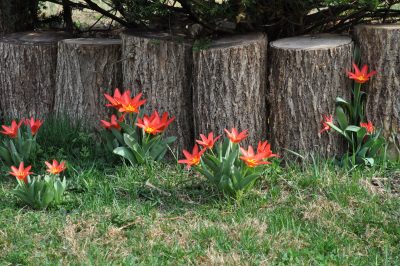 I’m banking, for instance, on the slightly warmer temperatures near the wall of my house to get my stewartia tree, which is borderline hardy here, through our winters. (It has.) And I expect spring to arrive early each year, with a colorful blaze of tulips, in the bed pressed up against the south side of my house. Proximity to paving also warms things up a bit.
I’m banking, for instance, on the slightly warmer temperatures near the wall of my house to get my stewartia tree, which is borderline hardy here, through our winters. (It has.) And I expect spring to arrive early each year, with a colorful blaze of tulips, in the bed pressed up against the south side of my house. Proximity to paving also warms things up a bit.
Microclimate for cold, microclimate for warmth
Microclimate isn’t always about trying to keep a plant warmer in winter, or speeding up growth in spring. It’s also useful for keeping plants cooler. By training my hardy kiwifruit (Actinidia spp.) vines right up against the shaded, north sides of their hefty supports, I keep the sun off their trunks in winter and avoid the splitting that occurs when trunks are warmed during winter days, then precipitously cooled as the winter sun drops below the horizon. 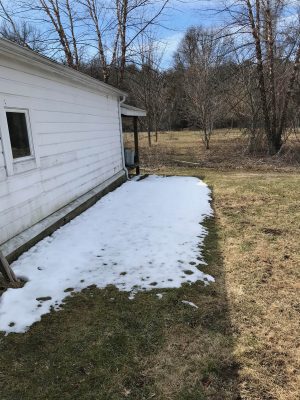 By planting the coveted blue poppy in a bed on the east side of my house, I hoped to give the plant the summer coolness that it demands. (That east bed was still too sultry; the plants collapsed, dead.)
By planting the coveted blue poppy in a bed on the east side of my house, I hoped to give the plant the summer coolness that it demands. (That east bed was still too sultry; the plants collapsed, dead.)
Microclimates are important when growing fruit plants that blossom early in the season because frozen blossoms do not go on to become fruits. Early season bloomers need microclimates that are slow to warm up.
South facing slopes stare full face at the sun, so these slopes warm up early in spring and are warmer in both summer and winter. Therefore, a south facing slope—even if the grade is only slight—can be used to hasten fruit ripening on a plant like persimmon, which blooms late but needs a long season when grown near its northern limits.
Right after I push soil over the first seeds of sweet corn that I plant, I firm it over that hole with my foot at an angle to make a south-facing depression in the ground. That mini-slope will warm up just a wee bit sooner than flat ground.
The sun glances off north slopes, delaying their warming in spring and keeping them cooler in summer. Such a microclimate is ideal for an early blooming fruit tree like apricot or peach, and for plants, such as sweet peas, that enjoy cool summer weather. Likewise ideal for such plants is near the north side of a building, where shade remains through winter and the early part of the growing season.
If a slope actually has some elevation to it, the air is going to cool by one degree Fahrenheit every three-hundred feet going up the slope. If I had sloping ground, which I don’t, and sought a cooler location for planting, I’d avoid planting at the very top of the slope, though, because the upper reaches are usually windy.
A cold spot, here
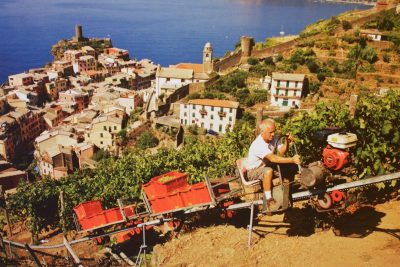
Ideal vineyard site, from plant perspective, in Germany
Counterintuitively, the very bottom of a slope will also be a cooler microclimate. On nights when the sky is clear, with no clouds or leafy trees to block re-radiation of the sun’s heat from the ground back to the heavens, the air at ground level cools. An “inversion” occurs, with warmer air higher up. The cold air, which is denser than warm air, flows downhill to settle into depressions, just as a liquid flows downhill. A low point would be the worst possible location for planting strawberries, which grow near ground level and whose early blossoms are threatened by late frosts in spring. Any dense fence or shrubbery on a slope stops the downward flow of cold air, which will pool, just as dammed water would, near the upper side of the barrier.
Among the fruits I grow are apples, peaches, plums, and pears, all of which tend to bloom early. My site, unfortunately, is just about the worst possible site for growing these fruits. 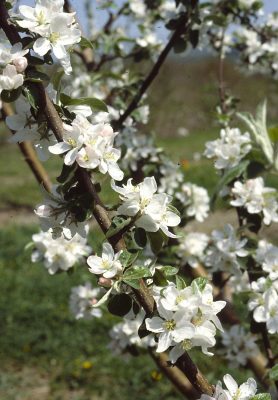 The cold air that settles here on clear spring nights increases the likelihood of late frosts and also causes moisture to condense on the plants, leaving them more susceptible to disease. Hence my envy for that sloping vineyard site.
The cold air that settles here on clear spring nights increases the likelihood of late frosts and also causes moisture to condense on the plants, leaving them more susceptible to disease. Hence my envy for that sloping vineyard site.
Check out my new book, The Ever Curious Gardener, for more on microclimate!!
Doing Good with Saw and Lopper
/4 Comments/in Flowers, Fruit, Gardening, Pruning/by Lee ReichFruitful Pruning
To begin, I gave the bush in front of me a once over, eyeing it from top to bottom and assuring it that the next few minutes would be all to its good. It was time for my blueberries’ annual pruning, the goals of which were to keep them youthful (the stems, at least), fecund, and healthy.
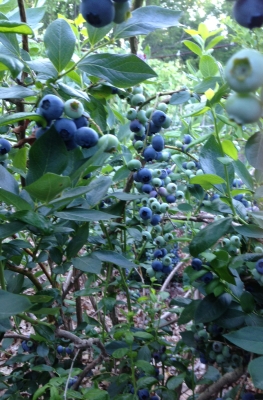
Blueberries galore
I peered in at the base of the plant, eyeing now the thickest stems. Blueberry bushes bear best on stems up to 6 years old, so the next move was to lop or saw any of these stems — usually only 3 or 4 of them, more on a neglected plant — as low as possible.

Sammy & me, pruning blueberries
To keep track of the ages of individual stems, I mark off the age of them each year with a Sharpie. Just kidding! The thickest ones are the oldest ones, and 6-year-old stems are generally an inch or more in diameter on healthy bushes.
Removing those stems that are over the hill frees up space for younger stems to develop. Each year blueberry bushes send up new sprouts from ground level, usually a few too many of them. They need to be thinned out so they don’t crowd each other as they age. I leave a half dozen or so of the most vigorous new sprouts, lopping all others to the ground.
That’s pretty much all there is to pruning a blueberry bush. With the very oldest and some of the very youngest stems cut to the ground, the bulk of pruning the bush is finished.
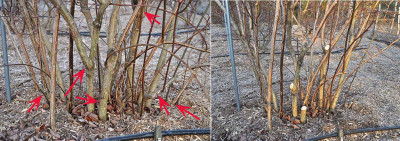
Blueberry bush, before & after pruning
I’ll also snip off any dead stems, remove a branch here and there where they are congested, and shorten any stems that will arch to the ground when laden with fruit.
That’s it. Finished, except to step back and admire my handiwork.
And Now, For Other Shrubs
The same pruning done on blueberry could, in essence, be applied to lilac,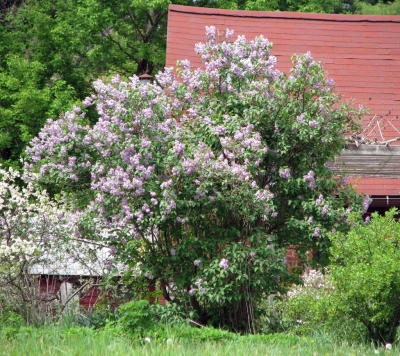 forsythia, mockorange, hydrangea, and any other informal shrub. This technique is known as rejuvenation pruning because, over time, the above ground portion of the shrub is annually rejuvenated. In the case of blueberry, the roots live unfettered year after year but the bush never sports stems more than 6 years old. A perennially youthful blueberry bush can go on like this, bearing well, for decades like this.
forsythia, mockorange, hydrangea, and any other informal shrub. This technique is known as rejuvenation pruning because, over time, the above ground portion of the shrub is annually rejuvenated. In the case of blueberry, the roots live unfettered year after year but the bush never sports stems more than 6 years old. A perennially youthful blueberry bush can go on like this, bearing well, for decades like this.
Not all shrubs perform best on stems up to 6 years old. Some, such as kerria, snowberry, rambling roses, and summer-bearing raspberries perform best on 1-year-old stems. So every year those 1-year-old stems are lopped to the ground and the youngest stems are thinned out.
Some shrubs, such as butterfly bush, everbearing raspberries, and red twigged dogwood, perform best on new stems. In this case, the whole plant gets lopped to ground level each year. (Everbearing raspberries actually bear on both new stems and on 1-year-old stems, so could be pruned as in the previous paragraph. That takes more time but does yield a midsummer crop on the 1-year-old stems and a late summer and fall crop on the new stems.)
At the other end of the spectrum in shrub pruning are witch hazel, tree peony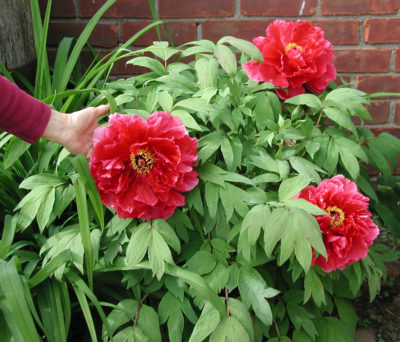 , rose-of-sharon, climbing roses, and flowering quince. These shrubs are among those that perform well year after year on the same old, and always growing older, stems. They also grow few or no suckers each year. The upshot is that thesis shrubs are the easiest to prune: Don’t.
, rose-of-sharon, climbing roses, and flowering quince. These shrubs are among those that perform well year after year on the same old, and always growing older, stems. They also grow few or no suckers each year. The upshot is that thesis shrubs are the easiest to prune: Don’t.
I detail the ages of stems that are “keepers” for every shrub, plus other details in pruning all kinds of plants, in my book The Pruning Book.
Getting Formal
All this pruning refers to informal shrubs. For formal shrubs, such as the privet hedge near one edge of my yard, I put aside the lopper, pruning shears, and pruning saw, and get out the hedge trimmer. Shearing all the youngest twigs, working, this time, higher in the bushes rather than down near ground level, elicits repeated branching which results in dense growth.
To keep this formal hedge clothed from head to toe in leaves, I keep the row of plants narrower towards their upper portions. This lets sunlight beam down on the shrubs from top to bottom.
And The Season Begins . . .
/8 Comments/in Gardening, Vegetables/by Lee Reich
St. Patty’s Day Passed; No Matter
Uh oh! St. Patrick’s Day was way passed and I hadn’t planted my peas. No matter. St. Patty’s Day is the right time to plant peas in Virginia, southern Missouri, and other similar climates, including, probably, Ireland.
Around here, in New York’s Hudson Valley, where the average date of the last killing frost is sometime in the latter half of May, April 1st is more like it. That’s the date that I shoot for, at least. Some springs, like the spring of 2017, earlier plantings would have done better. But you never know what bodes for the weather, so playing the averages is the best bet.
The problem with planting pea seeds too early is that the seeds will just sit and perhaps rot in cold soil. The problem with planting peas too late is that temperatures are too hot when the plants are supposed to be in all their glory, so they peter out rather than bear well. Again, an April 1st planting date, around here, generally works best.
Soil temperature is an even better guide than calendar date; pea seeds germinate when the soil warms to 40°F. Or a phenological indicator; blossoms of spring-flowering trees and shrubs open in response to warmth. Forsythia blossoms are just about to open at about the same time that the ground has warmed to that 40° temperature.
Get ‘Em Up
Peas grow as vines anywhere from a foot and a half tall to more that 6 feet long. Whether short or long, the vines are not self supporting. The laissez faire gardener just lets the vines sprawl on the ground, then lifts them to harvest.
For a neater garden and cleaner pods, I trellis my peas. By exploiting a third dimension — up — I also reap more productivity per square foot of garden space from trellised peas. 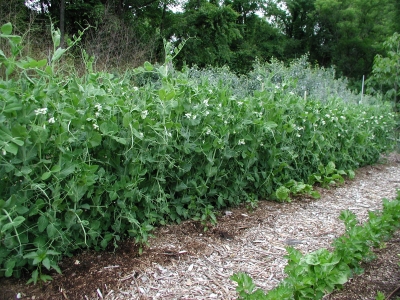 Plus, if the peas are planted down the center of my 3-foot-wide garden beds, I can flank them with other vegetables, such as carrots, radishes, lettuce, and arugula.
Plus, if the peas are planted down the center of my 3-foot-wide garden beds, I can flank them with other vegetables, such as carrots, radishes, lettuce, and arugula.
Peas, like other vegetables, should be rotated around the garden, that is, not planted in the same place again within 3 years. Crop rotation avoids the buildup of pest problems that overwinter in the ground. Without their host plants, they starve.
With this caveat, peas need temporary trellising, trellising that can follow them around the garden. Traditional temporary trellising for peas, and very British, are pea sticks. Looking quite charming, this trellis is made by merely sticking brushy twigs into the ground along the pea row. Pruning off branches sticking out perpendicular to the row leaves a flat plane of twigs up which the clinging vines can clamber.
The traditional pea trellis takes some time to set up and requires some time gathering a lot of suitable twigs.
Second Best Pea Trellis
I opt for the “second best pea trellis” which starts out by my pounding an old piece of inch-thick iron plumbing pipe into the ground at each end of my pea row. The trellis itself is chicken wire, each end of which I weave onto the pipes. The chicken wire can then be cut to the length of the row, or excess roll can just be left standing just beyond the pipe. The chicken wire slides down the pipes most easily if kept almost parallel to the ground, so I attach one end partway on one pipe, then the other end partway on the other pipe, and keep going back and forth easing the mesh down to the ground.
At this point, the trellis is quite floppy. I strengthen it with some of those inexpensive, fiberglass posts sold for electric fencing, weaving one of these posts into the chicken wire every three feet or so and then pushing it into the ground.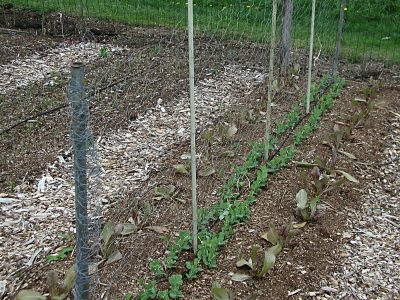
Presto! In about fifteen minutes, I’ve erected a serviceable and inexpensive pea fence. This fence can be erected just after the peas emerge through the soil, so what it lacks in beauty it makes up for by spending little time uncovered with pea vines. After pea harvest is over, I pull the vines down off the trellis and dismantle the fence in a reversal of the steps described. The fence, not being permanent, can move around the garden to a different location each spring — just as should the peas.